Social Media Listening Tools Comparison for Smart Brands
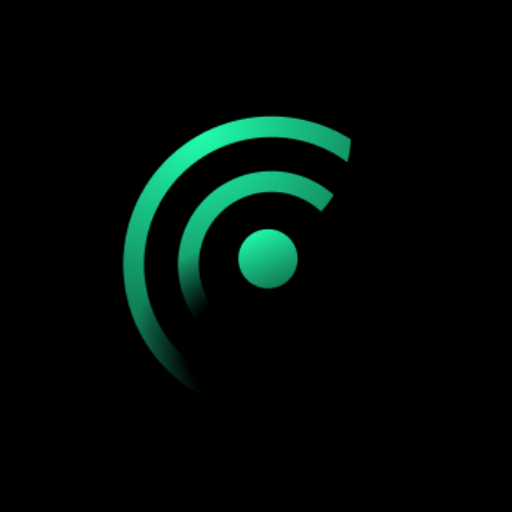
Let's be clear about one thing right away: social media listening and monitoring are not the same. It's a common mix-up, but the difference is fundamental.
Monitoring is about tracking mentions and engagement—it's reactive. Think of it like answering a ringing phone. Listening, on the other hand, is about analyzing the sentiment and trends behind those conversations. It's proactive, like doing market research to figure out what customers will want next.
Why Social Listening Is No Longer Optional
Not too long ago, social listening was a "nice to have." It was a secondary task for the marketing team, mostly used to keep an eye on campaign mentions or catch the occasional customer service fire before it got out of hand.
Today, that's completely changed. Social listening has become a core business intelligence function. The brands that are winning aren't just reacting to tags; they're proactively digging into millions of public conversations to guide strategy, spot risks, and spark innovation.
It’s a shift from just passively watching to actively analyzing. Instead of simply counting how many times your brand was mentioned, businesses are now trying to understand the why behind the chatter. This deeper insight gives you a serious competitive edge, turning what looks like random social noise into a strategic asset that can shape decisions across the entire company.
From Tactic to Strategic Imperative
The real value of social listening goes far beyond the marketing department. It delivers raw, unfiltered insights that can steer some of the most critical parts of a business.
- Reputation Management: Listening tools are your early warning system. They help you catch negative sentiment or potential crises before they blow up. Staying on top of these conversations is non-negotiable for brand health. Our guide on social media reputation monitoring dives deeper into this.
- Competitive Analysis: By tuning into the discussions around your competitors, you can pinpoint their strengths, weaknesses, and what their customers are complaining about. This is where you find market gaps and opportunities just waiting for you to jump on them.
- Product Innovation: Customer conversations are an absolute goldmine of feedback and feature requests. Listening helps product teams get a real feel for what users actually want, guiding them to build solutions that solve real-world problems.
Social listening is about understanding the market, not just managing your mentions. It’s the difference between hearing noise and recognizing a pattern that can redefine your entire business strategy.
This strategic shift is clearly reflected in the market's growth. The global social media listening market was valued at a massive USD 9.2 billion in 2024 and is expected to more than double, hitting USD 20.18 billion by 2030. You can explore the full market research about social media listening growth to see just how central it's becoming.
This diagram shows how it all works—a continuous cycle of monitoring conversations, analyzing the data, and feeding those insights right back into your business strategy.
The biggest takeaway here is that listening isn't a one-and-done task. It's a constant loop of learning and adapting, all based on what people are saying and feeling in real-time.
How to Choose the Right Social Listening Tool
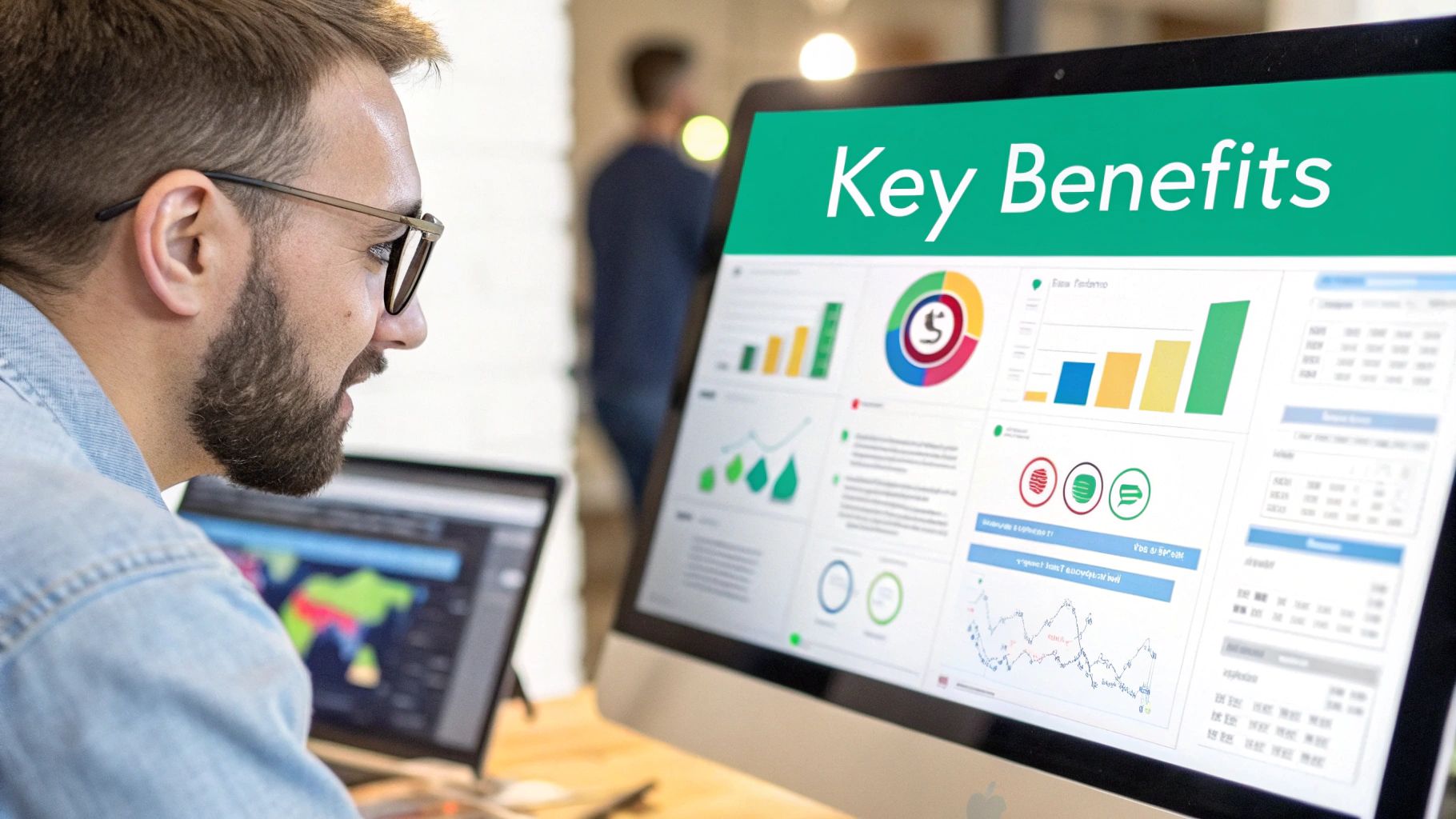
With so many social listening platforms out there, it’s easy to get distracted by flashy dashboards and long feature lists. But picking the right tool isn't about finding the one with the most bells and whistles—it's about finding the one that solves your specific business problems.
Before you even start comparing options, you need to be crystal clear on what you're trying to accomplish. What job are you hiring this tool to do? Your answer is the only thing that matters, as it will guide every decision you make. Without that clarity, you'll end up with a powerful, expensive tool that just gathers dust.
Define Your Core Objectives
First things first: what problems are you trying to solve? Are you looking to safeguard your brand's reputation, sniff out sales leads, or get the inside scoop on your competitors? Each of these goals requires a completely different set of features.
Think of it like building a simple decision-making framework. Your goals will likely fall into one of these buckets:
- Lead Generation: Your sales team needs a direct line to people who are actively looking for a solution like yours. For this, you need a tool like Intently that’s built to spot buying signals and purchase intent in conversations happening right now.
- Brand Health Monitoring: Your main concern is keeping an eye on brand sentiment and catching potential PR fires before they spread. This means you’ll need rock-solid sentiment analysis and instant alert capabilities.
- Competitive Intelligence: You need to know what your competitors are up to and what their customers are complaining about. Look for tools that offer robust competitor tracking and share-of-voice metrics.
- Product Research: You’re on the hunt for raw, unfiltered customer feedback to drive your next big innovation. Your tool absolutely must cover the niche forums, Reddit threads, and communities where people share their honest opinions.
Evaluate Data Sources and Analytics Depth
Not all social listening tools are pulling from the same well. Most will cover the big players like X (formerly Twitter) and Facebook, but the real gems are often found in less obvious places—think Reddit, LinkedIn, specialized forums, and blogs. Make sure the tool you choose is actually listening where your audience is talking.
Next, look at how deep the analytics go. Can the platform tell the difference between genuine frustration and sarcastic praise? Can it spot emerging trends before they hit the mainstream? The quality of AI-powered sentiment analysis varies wildly from one tool to another, and it can make or break the value you get.
The best social listening tool isn't the one with the most features; it's the one that delivers the most relevant insights for your specific business goals with minimal noise.
Finally, think about how it will fit into your current workflow. A tool that plugs right into your CRM or other business intelligence platforms is going to be far more useful in the long run. It allows you to build a richer, more complete picture of your customers.
To see how different platforms stack up against your goals, it helps to check out a broad market overview. A good roundup of the 12 best social listening tools can give you a solid baseline for comparing features, strengths, and weaknesses against what you actually need.
An In-Depth Social Media Listening Tools Comparison
Choosing a social media listening tool is a lot like picking a vehicle. You wouldn't buy a sports car to haul lumber, and you wouldn't take a semi-truck on a casual Sunday drive. It’s all about matching the tool to the job. The same logic applies here—a platform that’s perfect for a B2B sales team hunting for leads will likely fall flat for a consumer brand doing deep market research.
This comparison isn’t just a rehash of feature lists. We’re going to dig into what really sets platforms like Intently, Brandwatch, and Talkwalker apart when you put them to work in the real world. By looking at practical differences, you'll be able to see which tool’s specific strengths will actually make a difference for your team.
Differentiating by Core Use Case
The biggest mistake I see people make is comparing these platforms feature-for-feature. While many of them seem to do similar things on the surface, they're often engineered to solve very different problems. One might be a finely tuned engine for sales intelligence, while another is built for deep consumer research or brand health monitoring.
For instance, a tool like Intently is completely focused on spotting high-intent conversations and buying signals. It’s built for sales and marketing teams who need to find leads, period. On the flip side, a powerhouse like Brandwatch is designed for massive-scale data analysis, serving market researchers and big-brand strategists.
A critical mistake in any social media listening tools comparison is treating all platforms as equals. The right tool for you is the one that is purpose-built to solve your most pressing business challenge, not the one with the longest feature list.
Getting this fundamental difference right from the start is the key to picking a tool that delivers a real ROI.
Intently: The B2B Lead Generation Specialist
Intently has carved out a very specific, very valuable niche: sales intelligence and lead generation. Its whole purpose is to sift through channels like Reddit, X (formerly Twitter), and LinkedIn to find conversations where people are actively looking for solutions or signaling that they’re ready to buy.
This makes it a totally different beast from broader listening platforms. Instead of giving you a massive firehose of brand mentions, Intently’s AI acts more like a sniper, picking out actionable opportunities for your GTM teams.
- Best For: Sales teams, solopreneurs, and marketers who need a direct pipeline of warm leads from social media.
- Key Differentiator: Its AI is trained to zero in on buying signals—things like users asking for recommendations, complaining about a competitor, or discussing a problem your product solves.
- Ideal Scenario: A B2B SaaS company wants to find project managers on Reddit complaining about their current workflow software. Intently can flag these conversations in real-time, letting the sales team jump in with a helpful solution right away.
This laser focus means you get way less noise and a lot more signal, which is exactly what you need when your performance is measured in closed deals, not just brand mentions.
Brandwatch: The Enterprise Consumer Intelligence Engine
Brandwatch plays in a completely different league. It's an enterprise-grade consumer intelligence platform built for deep, sprawling market research and big-picture brand analysis. With access to over 100 million data sources and historical data stretching back more than a decade, its main strength is its sheer scale and analytical power.
This is the go-to tool for global brands that need to understand macro trends, run complex demographic analysis, and turn massive datasets into strategic insights. For companies weighing their options at this level, looking into Brandwatch alternatives can offer a clearer picture of the competitive landscape.
- Best For: Large enterprises, market research firms, and agencies managing global brands.
- Key Differentiator: Its advanced data visualization tools (Vizia) and sophisticated Boolean query builder let you slice and dice data in incredibly granular ways.
- Ideal Scenario: A global CPG brand needs to analyze how consumers feel about sustainable packaging across different countries and languages. Brandwatch can crunch millions of mentions, segment them by location and emotion, and spit out an interactive dashboard for the C-suite.
The complexity and price tag reflect this focus on heavy-duty analysis, making it overkill for smaller teams or those with more direct lead gen goals.
Talkwalker: The Global Brand Health Monitor
Talkwalker sits nicely in the middle, balancing broad monitoring with actionable insights. This makes it a fantastic choice for brands focused on managing their reputation and spotting potential crises before they blow up. It covers more than 30 social networks and 150 million websites, and its AI-driven sentiment analysis and visual listening are top-notch.
Talkwalker’s real magic is its ability to spot brand logos in images and send out predictive alerts. It's like having a 24/7 guardian for your brand's health, helping PR and comms teams get ahead of negative stories.
- Best For: PR and communications teams, mid-to-large businesses, and brands with a major global footprint.
- Key Differentiator: Its visual listening tech and predictive alerts act as an early-warning system for PR crises or sudden shifts in brand sentiment.
- Ideal Scenario: An international airline needs to watch for customer service meltdowns and safety concerns across the globe. Talkwalker can spot a surge of negative photos from a specific airport and alert the PR team before it becomes a trending news story.
The infographic below really nails how these tools stack up on the important stuff—platform support, sentiment accuracy, and what you can expect to pay.
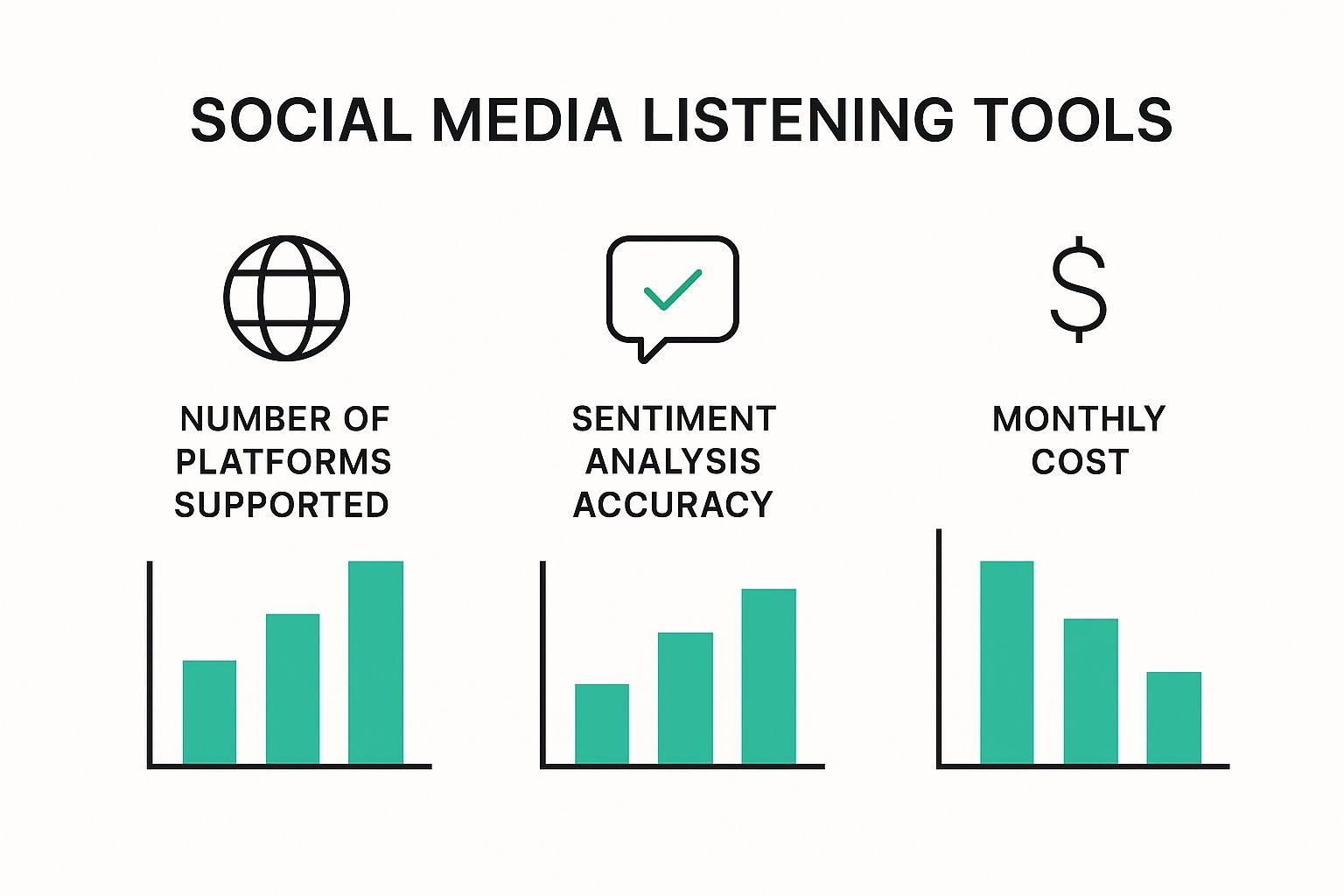
As you can see, there’s a clear trade-off. The platforms with the widest data coverage and most precise analytics often come with enterprise-level price tags, while specialized tools can deliver targeted value for a much more accessible price.
Side-by-Side Feature Analysis of Leading Tools
To really drive home the differences, it helps to put these tools head-to-head on the criteria that matter most to different teams. Looking at them side-by-side makes it obvious where each one shines.
| Feature | Intently | Brandwatch | Talkwalker | Sprinklr |
|---|---|---|---|---|
| Primary Goal | B2B Lead Generation | Deep Consumer Research | Brand Health & Crisis Management | Unified Customer Experience |
| Core User | Sales & Marketing Teams | Market Researchers & Analysts | PR & Communications Teams | Enterprise Marketing & CX |
| Data Focus | High-intent buying signals | Macro trends & historical data | Real-time sentiment & visual mentions | End-to-end customer journey |
| Key Channels | Reddit, X, LinkedIn | 100M+ sources (forums, blogs) | 30+ social networks, 150M+ websites | 30+ channels, including owned |
| Pricing Model | Accessible, starts at $49/mo | Custom Enterprise Pricing | Custom Enterprise Pricing | Custom Enterprise Pricing |
| Greatest Strength | Actionable, conversion-focused alerts | Unmatched data depth and visualization | Proactive reputation monitoring | All-in-one platform integration |
This table really highlights why you need to start with your end goal. If your main objective is to fill the sales pipeline, Intently's focused approach is a clear winner. But if you're tasked with creating a massive market trends report for the board, Brandwatch is the logical choice.
There’s no denying how important these tools have become. As of early 2025, a whopping 62% of marketers are using social listening platforms to shape their strategies and prove ROI. It's now the second-highest priority for social media teams, right after direct audience engagement. The tool you choose will have a direct impact on how well you can tap into those insights and turn them into results.
How AI Is Transforming Social Listening
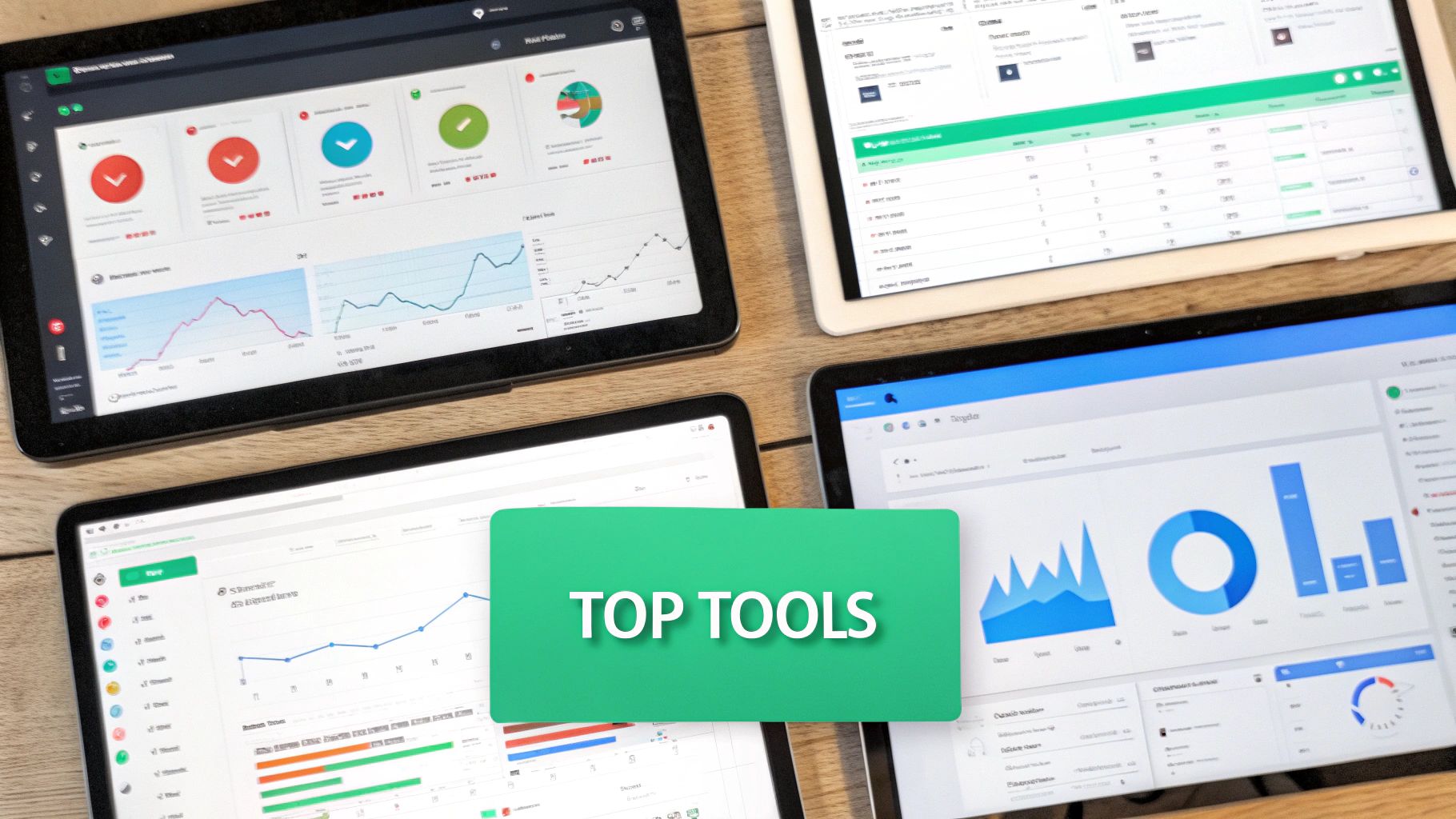
Artificial intelligence isn't just a buzzword anymore; it's the engine driving the next wave of social listening. The old tools were decent at tracking keywords, but they often fell flat when it came to understanding the real context or emotion behind a mention. This is where AI changes the entire game.
Using technologies like natural language processing (NLP), AI can make sense of human language—including all its messy parts like sarcasm, slang, and irony—with surprising accuracy. It goes way beyond simple "positive" or "negative" tags, giving brands a much richer feel for what customers are actually thinking.
AI essentially elevates any social media listening tools comparison by shifting the conversation from what people are saying to why they're saying it. It’s the difference between hearing a bunch of noise and actually understanding the dialogue.
Enhanced Sentiment Analysis Accuracy
One of the biggest wins for AI has been in sentiment analysis. Early versions were known for some pretty comical mistakes, like flagging sarcastic praise as a genuine compliment. Today's AI-powered platforms are light-years ahead, delivering insights you can actually rely on.
The evolution here has been fueled by advancements in generative models like GPT-4. While older methods fumbled with nuance, integrating these large language models has pushed binary sentiment detection accuracy to around 93%.
That level of accuracy means brands can confidently use the data to make big decisions—whether that's tweaking a marketing message on the fly or jumping on a customer service issue before it snowballs.
AI doesn’t just count mentions; it deciphers intent. This capability transforms raw social data from a retrospective report into a predictive tool for understanding market movements.
For instance, AI can sift through thousands of comments on a product launch video. It won't just tell you the sentiment is positive; it will identify recurring themes in the feedback. Maybe it spots that a specific feature keeps getting mentioned with a hint of frustration, giving your product team a clear, actionable insight.
From Reactive Monitoring to Predictive Insights
The real magic of AI in social listening is its ability to look forward, not just back. By chewing through massive amounts of historical and real-time conversation data, AI algorithms can spot emerging trends before they hit the mainstream. This gives businesses a serious leg up on the competition.
- Crisis Detection: AI can spot unusual spikes in negative chatter or certain keywords tied to a potential PR nightmare, giving your team a heads-up before the story blows up.
- Trend Identification: By tracking subtle shifts in language and topics, AI can flag what's bubbling up, helping marketing teams create campaigns that are timely and relevant.
- Sales Opportunity Recognition: AI can pinpoint conversations that signal buying intent, like someone asking for a recommendation or complaining about a competitor. This is a core function in platforms like Intently and a key part of the complete guide to AI lead generation tools.
Imagine an AI noticing a small but growing number of Reddit users discussing a particular pain point in your industry. It flags this as an emerging need, allowing your product team to start exploring a solution before your competitors even know the opportunity is there. That's what separates modern, AI-driven tools from everything that came before.
Practical Use Cases for Social Listening
Seeing the features of different platforms on a list is one thing, but watching them work in the real world is where their value truly clicks. A solid social media listening tools comparison has to go beyond feature checklists and show how these tools actually solve real problems for different teams. The magic happens when raw data gets turned into a smart business decision.
Let’s walk through a few practical scenarios to show how different departments can use social listening to get measurable results. These examples show how the right tool, used the right way, can make a difference in everything from marketing campaigns to B2B sales pipelines.
Marketing Teams Refining Campaign Messaging
Imagine a CPG brand launching a new line of plant-based snacks. Their first campaign pushes hard on health benefits and organic ingredients. But two weeks in, the marketing team uses a tool like Talkwalker to see what people are really saying.
Instead of just counting brand mentions, they look at the sentiment and themes driving the conversation. The AI analysis points to something they missed completely: while some people like the health angle, the most passionate posts are coming from fitness influencers and gym-goers who love the snack’s high protein content for post-workout fuel.
Armed with this insight, the team pivots fast.
- Action Taken: They tweak their social media ad copy and images to spotlight the protein benefits.
- New Targeting: They shift some of their ad budget to reach fitness-focused audiences.
- Result: Within a week, engagement on their ads jumps by 45%, and online sales from social media get a nice boost.
This shows how listening gives you real-time feedback, letting you make quick adjustments that connect better with the people who are actually buying your product.
Product Teams Identifying High-Demand Features
A mid-sized SaaS company that makes project management software is planning its next product roadmap. All their internal feedback suggests users want more ways to customize dashboards. But the product team decides to look beyond their own channels.
Using a platform with deep data coverage like Brandwatch, they start listening to conversations on Reddit (specifically r/projectmanagement), industry forums, and X (formerly Twitter). They're not just tracking mentions of their own product; they’re also looking at complaints about their top three competitors.
The best product feedback often comes from conversations where customers don’t even know you’re there. Unsolicited, honest opinions are a goldmine for innovation.
The analysis reveals a common thread: users on every platform are constantly annoyed by the lack of simple, one-click integrations with time-tracking apps. This pain point comes up way more often—and with much stronger frustration—than the desire for custom dashboards.
- Action Taken: The product team reshuffles the roadmap, putting the development of a time-tracking integration at the top of the list.
- Result: When the new feature goes live, it becomes their most-talked-about update of the year, leading directly to a 15% drop in customer churn the following quarter.
B2B Sales Teams Pinpointing Buying Intent
For B2B companies, sales cycles are long, and finding qualified leads is always a struggle. This is where a specialized tool like Intently can make a huge difference. Let's say a cybersecurity firm wants to find small business owners who are actively searching for new security solutions.
Their sales team uses Intently to create very specific alerts. They’re not just looking for mentions of "cybersecurity." They're listening for clear buying signals, like:
- "Can anyone recommend a good firewall for a small business?"
- "We just got hacked, need to upgrade our security ASAP."
- "Feeling overwhelmed by compliance requirements, what tools can help?"
When someone posts a question like this on LinkedIn or Reddit, Intently identifies it as a high-intent lead and shoots a real-time alert to the sales team's Slack channel. This lets a sales rep jump into the conversation naturally, offering helpful advice instead of a hard pitch. It turns a cold outreach into a warm, relevant conversation. This targeted approach is a core part of modern B2B outreach; you can discover more strategies in this beginner's guide to B2B lead generation. This process dramatically increases the odds of booking a demo and closing a deal.
Making Your Final Decision and Driving Adoption
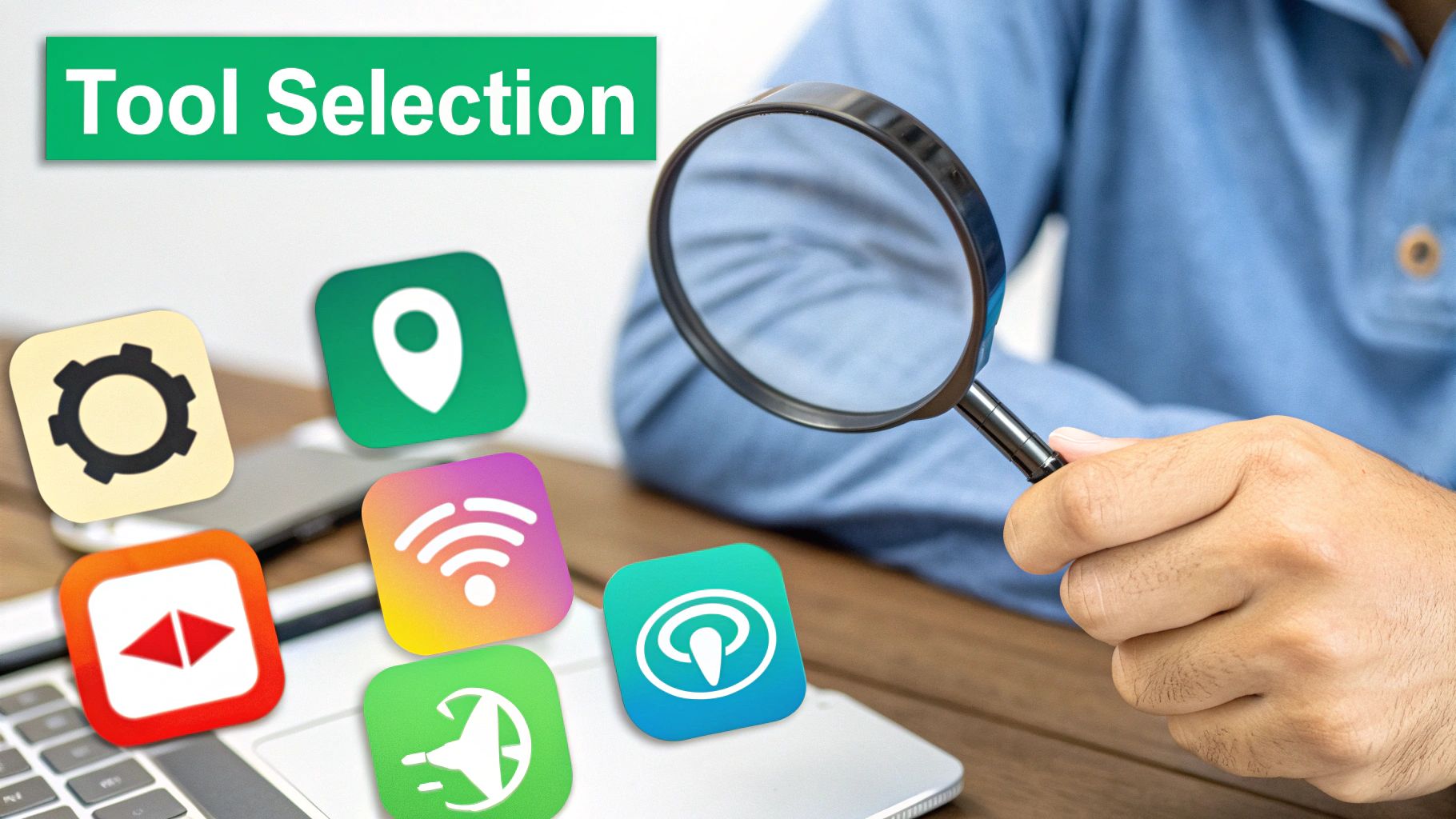
Picking a platform from a long social media listening tools comparison is just the starting line. The real work—and where you actually get your money's worth—is getting your team to use it day in and day out. After all, a powerful tool gathering dust is just an expensive line item.
Making the right choice comes down to balancing your big-picture goals with real-world constraints like budget and team capacity. Getting everyone on board, though? That’s all about having a smart rollout plan that turns raw data into action. This is where the tool stops being a new toy and becomes essential to how you work.
Creating a Decision Framework
Don't get lost in a sea of features. Build a simple framework to keep your decision grounded in what the business actually needs, not just what the tool can do.
- For B2B Sales Teams: If your number one goal is digging up actionable leads, your framework has to prioritize tools with sharp intent signal detection. A platform like Intently, which is built to find prospects actively hunting for solutions, is going to win out over a general-purpose monitoring tool.
- For Enterprise Brand Management: When brand health and market research are the main event, you need data depth and serious analytics. This is where a heavy-hitter like Brandwatch or Talkwalker becomes almost non-negotiable for analyzing huge trends and managing a global reputation.
- For Lean Marketing Teams: Small teams need tools that are efficient and deliver a clear ROI, fast. The best pick is often a tool that automates one high-value job really well, like finding content ideas or tracking competitors, without a steep learning curve or a massive price tag.
The right tool isn't the most powerful one on the market; it's the one that directly helps you hit your most important business goal. Nailing that alignment is how you make a smart investment.
Thinking this way keeps you from paying for features you’ll never touch. A nimble, sales-focused platform is a much better fit for a startup than a complex enterprise suite. Recognizing that difference is key to making a good financial call.
Driving Successful Team Adoption
Okay, you’ve made your choice. Now comes the hard part: implementation. A tool’s real success is measured by how deeply it’s adopted by the people who are supposed to use it.
To make sure your new platform becomes a go-to resource, you need a structured rollout plan. This is how you move it from "that new thing we bought" to a core part of your strategy.
- Set Up a Few Key Dashboards and Alerts: Don't try to boil the ocean. Start by building a handful of dashboards focused on your main goals—think competitor mentions, key product feedback, or high-intent keywords.
- Run Focused Team Training: Forget a generic one-hour overview. Tailor your training to specific roles. Show the sales team exactly how to find leads. Teach the marketing team precisely how to track campaign sentiment. Make it relevant to their daily jobs.
- Define Simple Workflows: Create dead-simple, repeatable steps for what to do with the insights. For instance, when a high-intent lead gets flagged, what is the exact process for the sales team to follow up?
- Share Early Wins Loudly: Hunt down the first few successes and celebrate them. When a lead from the tool closes, share that story with the whole company. It builds momentum and shows everyone the tool is delivering real value.
Getting a new platform integrated is a marathon, not a sprint. By starting small, giving role-specific guidance, and proving the tool's worth with actual results, you'll make sure it becomes a permanent and powerful asset for your team.
Ready to turn social conversations into qualified leads? Intently delivers real-time alerts when potential customers signal buying intent on platforms like Reddit, X, and LinkedIn. Discover actionable opportunities and start closing more deals today.
